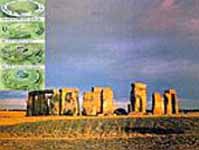
Archeologists discover another Stonehenge in the Russian city of Ryazan Pravda - July 6, 2005
Four thousand years old construction found in Russia

Archeologists discover another Stonehenge in the Russian city of Ryazan Pravda - July 6, 2005
Four thousand years old construction found in Russia
Russia: Stonehenge on Don Pravda - September 2004
Stonehenge: Built by Welshmen? Discovery - June 18, 2004
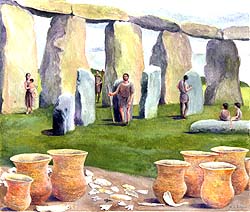
Tests reveal Amesbury Archer King of Stonehenge was a settler from the Alps Popular Science - February 2004
Lasers reveal invisible Stonehenge carvings October 2003 - New Scientist
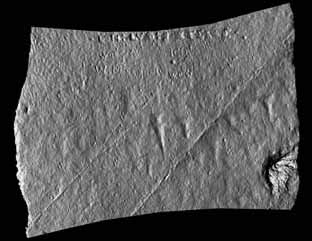
Laser scanning has revealed ancient carvings on the
pillars of Stonehenge that are invisible to the naked eye.
Stonehenge was a memorial to the dead when the 83 stones were carved.
German site predates Stonehenge BBC - August 2003
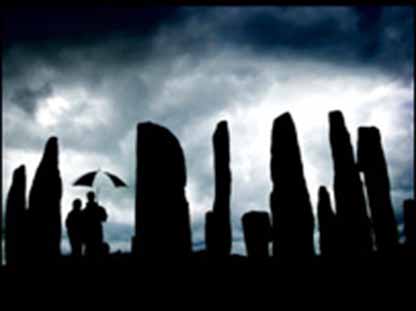
An ancient stone circle, buried for thousands of years, has been uncovered
by archaeologists at a sitein the Outer Hebrides. Experts say the discovery
is second in importance only to Stonehenge. The find was made close to the
four other existing stone circles at the famous standing stones of Callanish,
on the Isle of Lewis. The discovery of the 30m circle - which is at least 3,000
years old and predates Stonehenge.
'King of Stonehenge' hailed from the Alps February 2003 - New Scientist
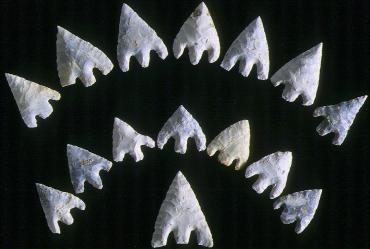
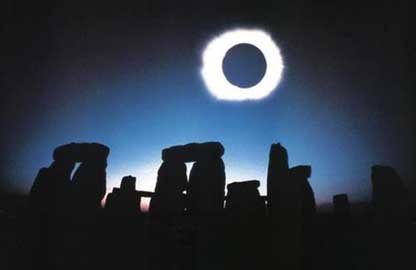
CNN - May 2003
Archaeologists who last year unearthed the remains of a Bronze Age archer at Stonehenge said this week that they have found six more bodies near the mysterious ring of ancient monoliths.
The remains of four adults and two children were found about half a mile from that of the archer, dubbed "The King of Stonehenge" by Britain's tabloid press. Archaeologists said he came from Switzerland and may have been involved in building the monument.
Radiocarbon tests will be done to find out more precise dates for the burials but the group is believed to have lived around 2300 B.C., during the building of Stonehenge at Amesbury, 75 miles southwest of London, said Wessex Archaeology, which excavated the site.
The latest bones discovered are about the same age of those of the archer, said Wessex Archaeology.
"This new find is really unusual. It is exceptionally rare to find the remains of so many people in one grave like this in southern England," said Andrew Fitzpatrick of Wessex Archaeology on Wednesday.
"The grave is fascinating because we are seeing the moment when Britain was moving from the Stone Age into the Bronze Age, around 2300 B.C."
Wessex Archaeology said it is possible the bones are those of people from different generations, as the grave seems to have been reopened to allow further burials.
The grave contained four pots belonging to the Beaker Culture that flourished in the Swiss Alps during the Bronze Age, some flint tools, one flint arrowhead and a bone toggle for fastening clothing, Wessex Archaeology said.
The large number of bodies placed in this grave is something more commonly found in the Stone Age, but the Beaker style pottery is characteristic of Bronze Age burials.
The archer was identified by the flint arrowheads found by his body. Archaeologists said some 100 artifacts found in his exceptionally rich grave, discovered about three miles from Stonehenge, indicate he was a man of stature and likely involved in constructing the monument.
Although the indigenous British originally came from mainland Europe, they settled thousands of years before the arrival of the archer, who clearly belonged to a different culture, marked by a new style of pottery, the use of barbed flat arrow heads, copper knives and small gold ornaments.
His grave contained teeth and bones as well as two gold hair tresses, three copper knives, flint arrowheads, wrist guards and pottery. The copper knives came from Spain and France. The gold dated to as early as 2470 B.C., the earliest dated gold objects found in Britain.
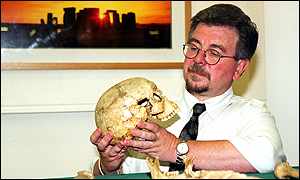
David Miles inspects the severed skull
June 9, 2000 - BBC
An ancient skeleton excavated from Stonehenge has revealed a grisly execution at the famous site.
The skeleton was unearthed in 1923 but was thought to have been destroyed in 1941 by the Nazi bombing blitz on London. At that time, it was being held at the Royal College of Surgeons, which suffered three direct hits.
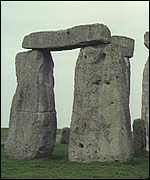
However, the chance discovery of a letter by an archaeologist researching a book led to the skeleton's re-discovery in the Natural History Museum.
Modern analysis techniques show that the skeleton belonged to a man aged about 35 who had his head cut off by a sword.
The man may have died 2,000 years ago, and it had been thought that his death was the result of natural causes.
English Heritage, who manage Stonehenge, said: "Why he was executed is not known. But it is possible that he was singled out for special punishment, as Stonehenge clearly represents a dramatic and important site for the event."
It was thought that Stonehenge, built in three phases between 3050 BC and 1600 BC, was abandoned by 1500 BC. But this evidence suggests the site retained importance centuries later.
Only one other complete skeleton from Stonehenge exists. It was excavated in 1978 from the ditch around the circle. The man had died in a hail of flint-tipped arrows. Two other skeletons have been found. One was probably a Roman, and was reburied at Stonehenge in 1922. The other was excavated in 1926 from the center of the circle and was possibly contemporary with the site, but has now been lost.
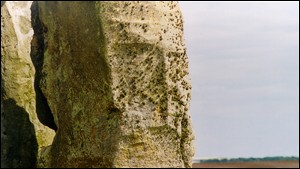
October 3, 1997 - BBC
Has the face of the creator of Stonehenge been staring at us unrecognized for more than 4,000 years?
A British archaeologist claims to have seen a face carved into the side of one of the mighty stones at Stonehenge.
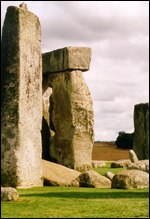
It is the first face ever seen on the Neolithic monument and one of the oldest works of art ever found in Britain.
It was recognised by Terrence Meaden, an archaeologist with a fascination for the ancient standing stones of the British Isles.
"I just happened to be there at the right time of day because only when the light is right can you see it properly. During the summer months it is only obvious for about a hour each day around 1400."
It is amazing that it has never been recognised before.
Dr Meaden believes that it was missed because previous researchers concentrated on the fronts of the standing stones and not their sides.
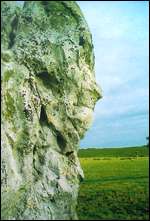
The particular viewing conditions to see it at its best will have also played a part in it not being seen. "But once you see it it's obvious," he says.
It seems to carry a serious expression, almost a frown, as it looks across the Salisbury plain.
Stonehenge was built about 2450 BC but why does Dr Meaden believe the carving was made at the time and was not done much later.
"Why would anyone do that?" he asks, "The type of stone, Sarsen, is the hardest stone know to man. It would have taken hundreds of hours working on a platform to do it. Why bother?"
Meaden's photographs are being evaluated by other archaeologists.
He also claims that other faces can clearly be seen on the Avebury stones not far from Stonehenge.
But who is the face of Stonehenge?
"We will never know," says Meaden, "He could be the patron of the monument or even its architect. Perhaps the designer of Stonehenge has been looking at us for four thousand years and we didn't see him."
That year Crop Circle Researcher - Colin Andrews - also discovered an unusual inscription in one of the stones.
Colin Andrews reports glyph discovered within Stonehenge:
The glyph, partly covered by lichen and obviously not a fresh carving, was discovered shortly before dusk while Colin was in the company of a Beyond Boundaries group. Upon sighting the unusual symbol Colin requested the assistance of a Glasgow newspaper photographer who was covering a story about the expedition. The side lighting on the photograph revealed more of the intriguing shape which is now is receiving international interest.